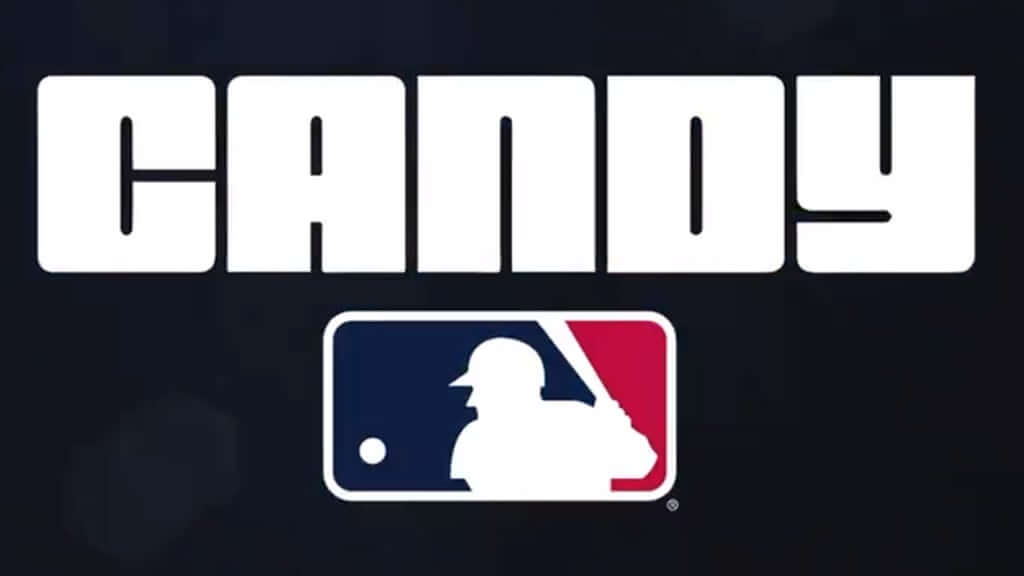
You’ve probably heard a lot in recent months about non-fungible tokens, or NFTs — unique, blockchain-based digital assets that have become a big deal in the art world. They’ve also gained a foothold in the realm of sports collectibles, especially in the NBA, where NFTs are sold under the league’s NBA Top Shots program.
Major League Baseball dipped its toe into the NFT pond in June, when it announced a partnership with the NFT operation Candy (a venture that, like so many things in sports merchandising, is co-owned by Fanatics). Their first digital collectible was a Lou Gehrig NFT, timed to coincide with the anniversary of Gehrig’s “Luckiest Man” speech, and they’ve launched additional products since then.
I’m not particularly interested in owning or collecting NFTs myself, but I do think they’re an interesting phenomenon. For example, they certainly raise some fascinating questions about the concept of value (which we’ve recently discussed here on the site), and I’m always curious about what collectors are collecting. So I was intrigued when I recently received an email from a Candy representative who I’ll call Dave (for all of these screen shots, you can click to enlarge):
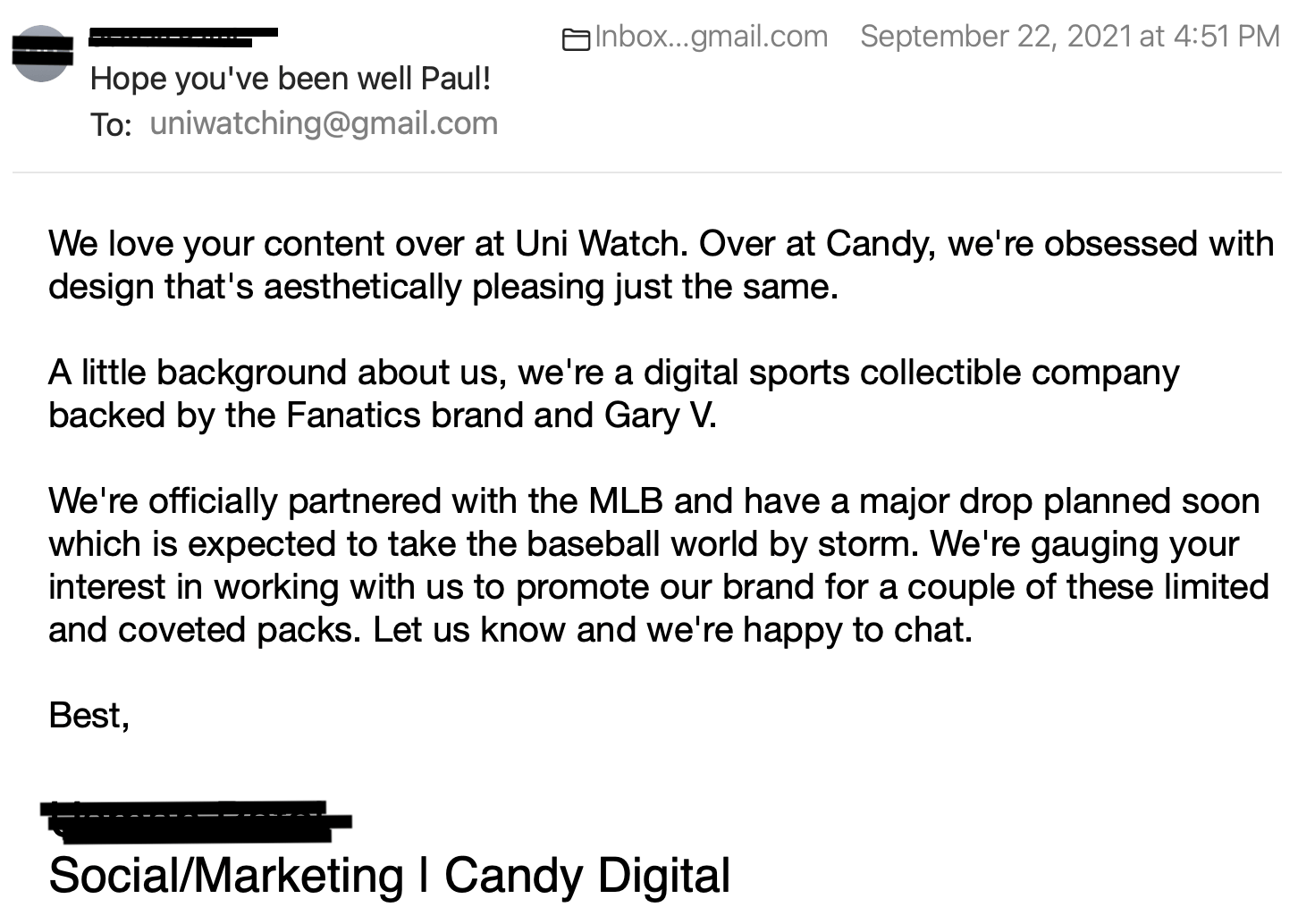
Publicists and marketers pitch me stories all the time (you should see all the emails I’ve recently received from the guy who wants me to write about a product that NFL kickers and punters use to take care of their feet!). Most of those pitches don’t interest me, but I thought MLB NFTs might be an interesting topic. I did think it was a bit odd that this particular story would be pitched my way, given that I’ve long been on MLB’s shit list (remember how they nixed my Topps trading card last year?), but I figured maybe the Candy people didn’t know about that. And yeah, of course being asked to “promote our brand” was sort of nauseating, but that’s just the way marketers talk. I figured it couldn’t hurt to learn a bit more, so I wrote back right away:
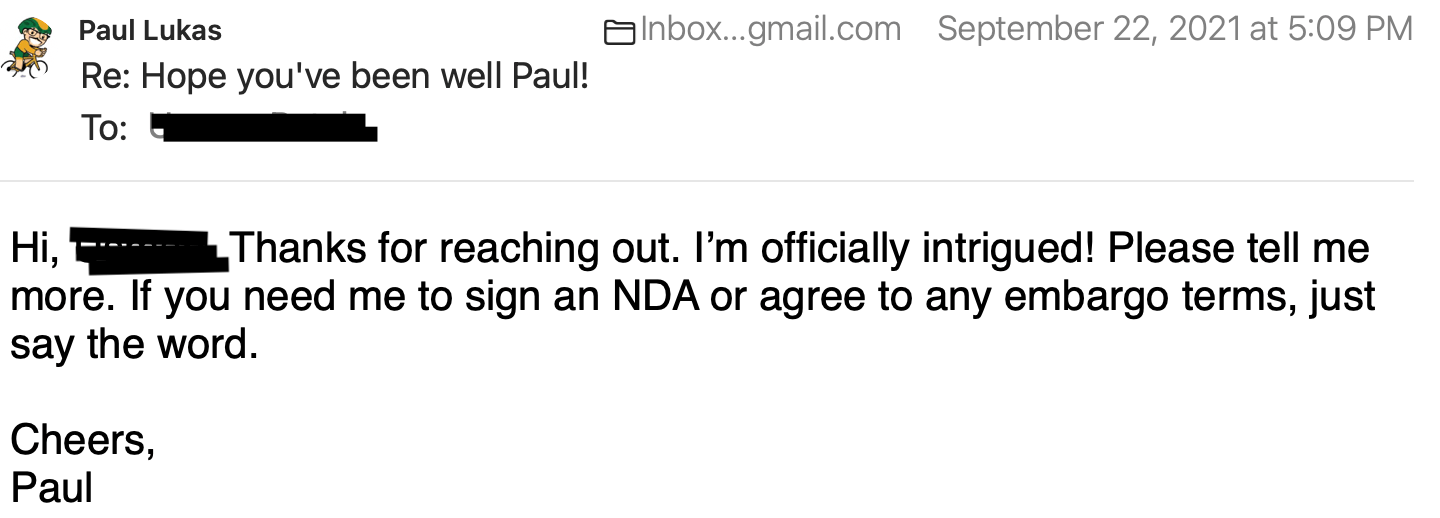
Two days went by — nothing. That’s a bit unusual, because publicists and marketers are usually very excited when a writer responds to a pitch, so I checked in with Dave. He responded a few hours later:
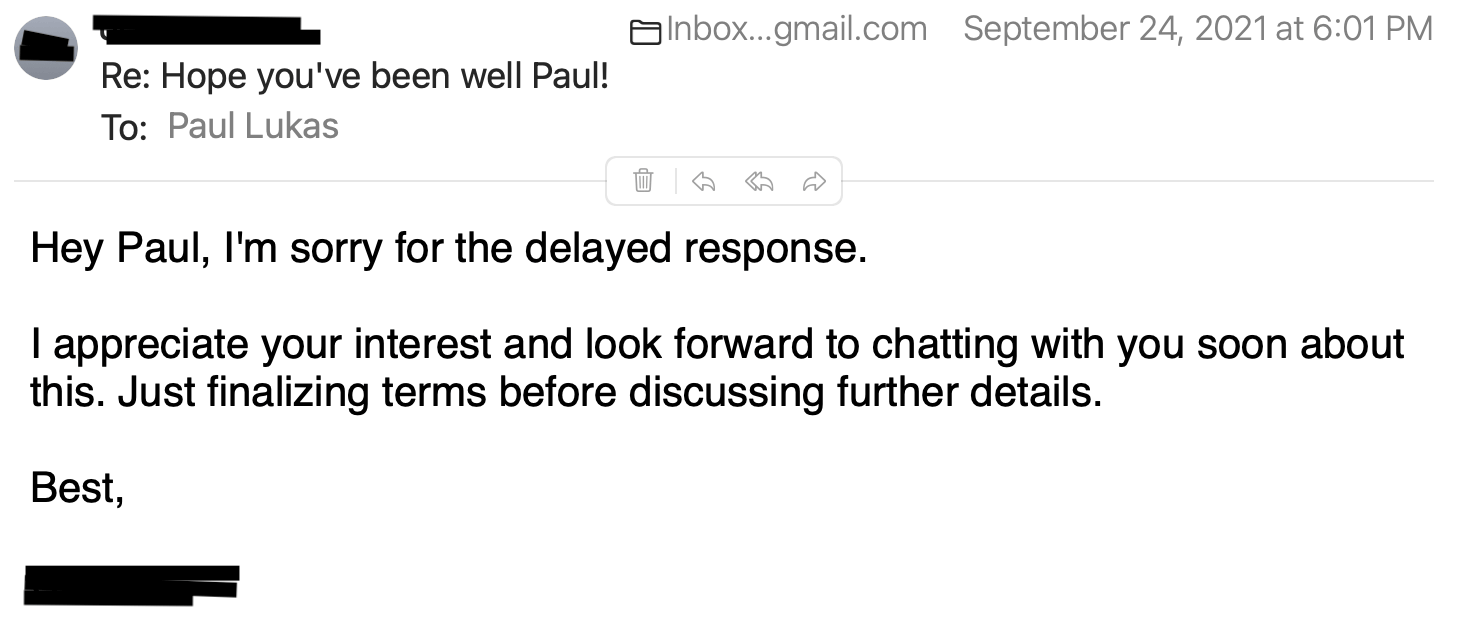
That was last Friday, so I wished Dave a good weekend and looked forward to hearing more from him whenever he was ready.
That turned out to be yesterday evening, when I received this:
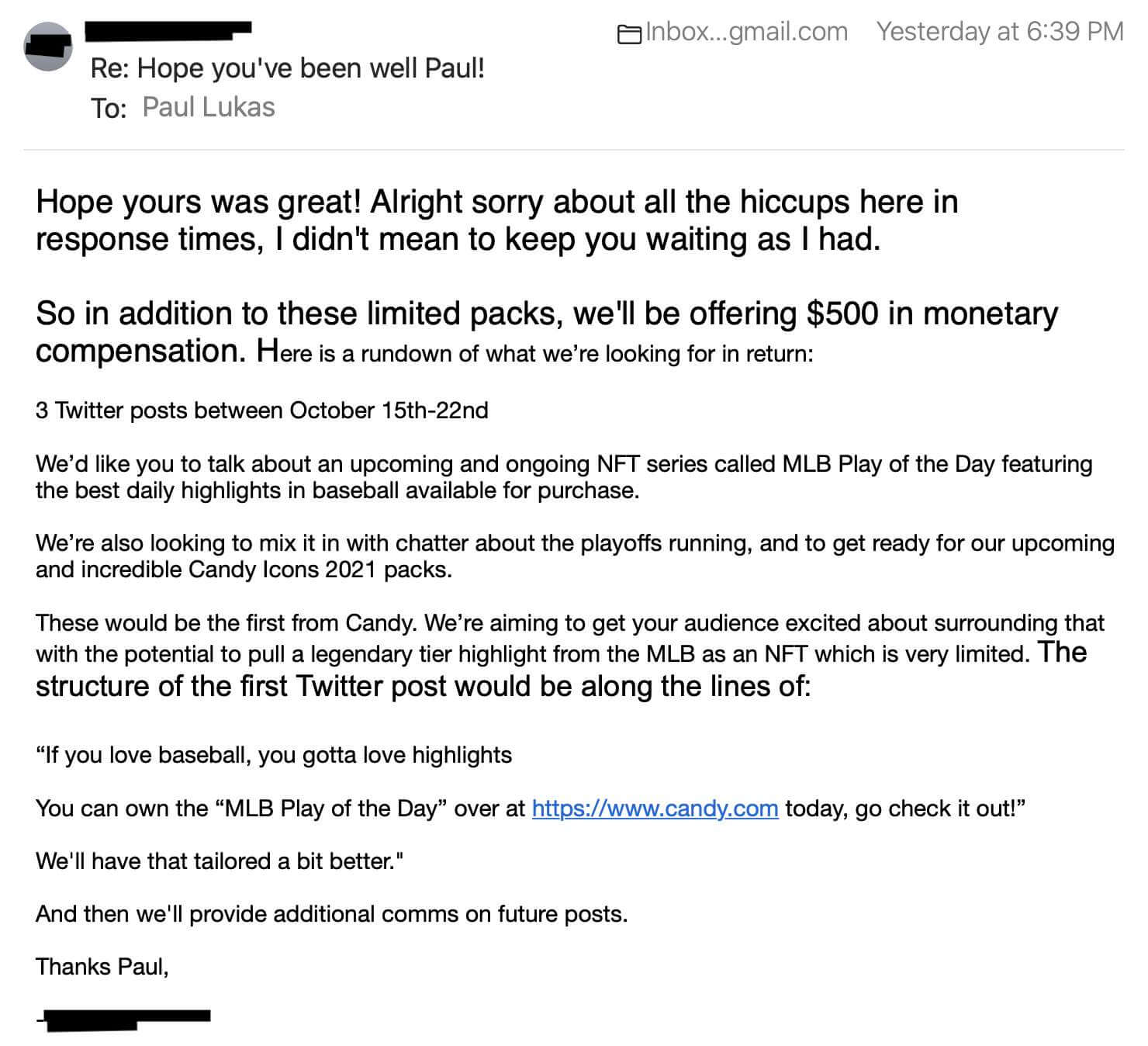
Ewww. So Dave wasn’t actually pitching me a story. He was trying to buy (and script!) my tweets. The whole “promote our brand” thing in the first email hadn’t been a euphemism — it was literally what they wanted from me.
Brands paying “influencers” to promote various products on social media happens all the time, of course (there’s even a new startup called Fuck You Pay Me that helps influencers figure out how much brands are offering other influencers), but I never thought anyone would approach me to be a part of it. I have to admit that it was an exciting opportunity — just think, I too could be an influencer, just like some 17-year-old talking about the latest beauty products on TikTok, whoo-hoo! — but of course I couldn’t do that. I wrote back to Dave:
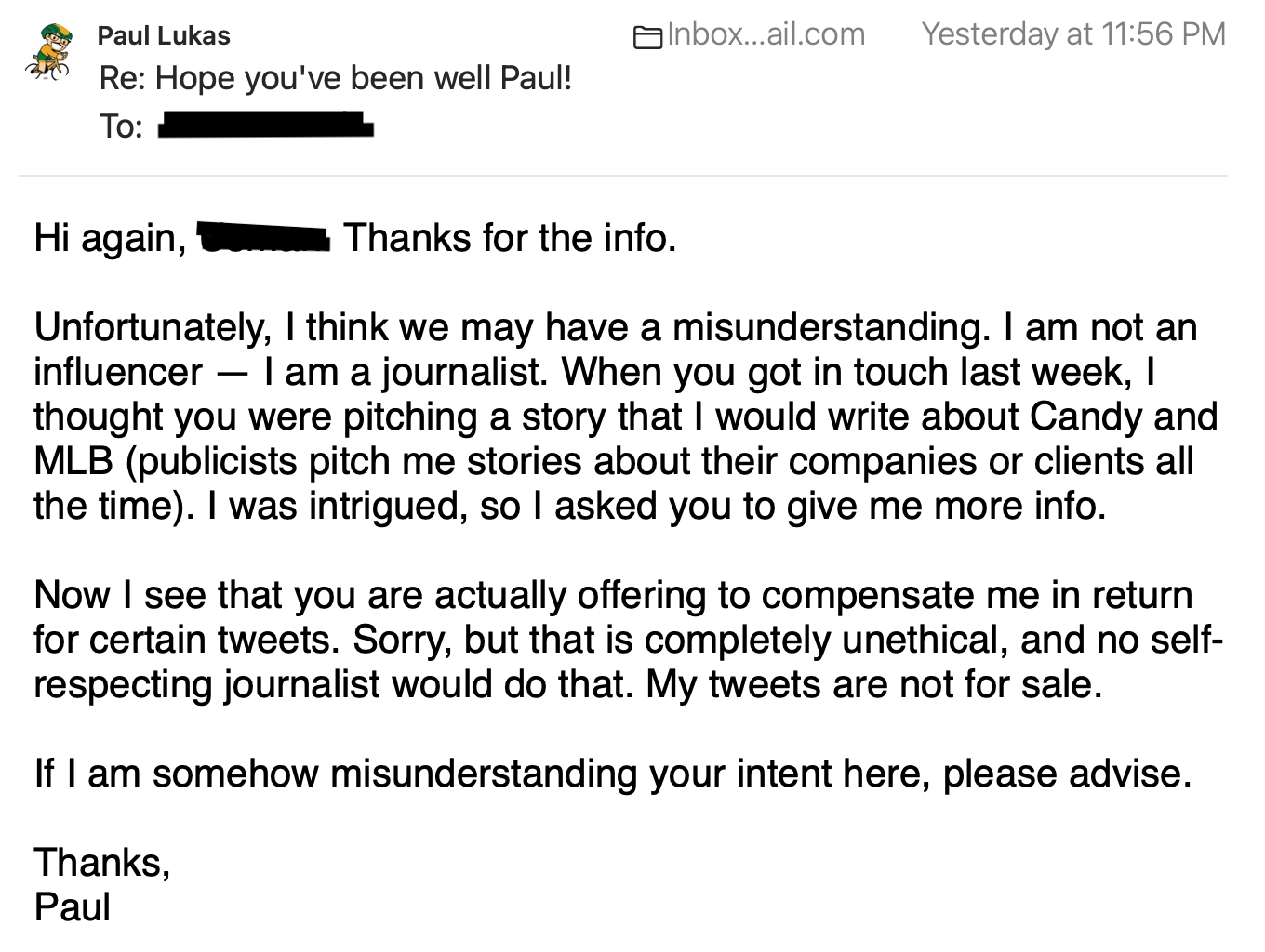
He responded quickly:
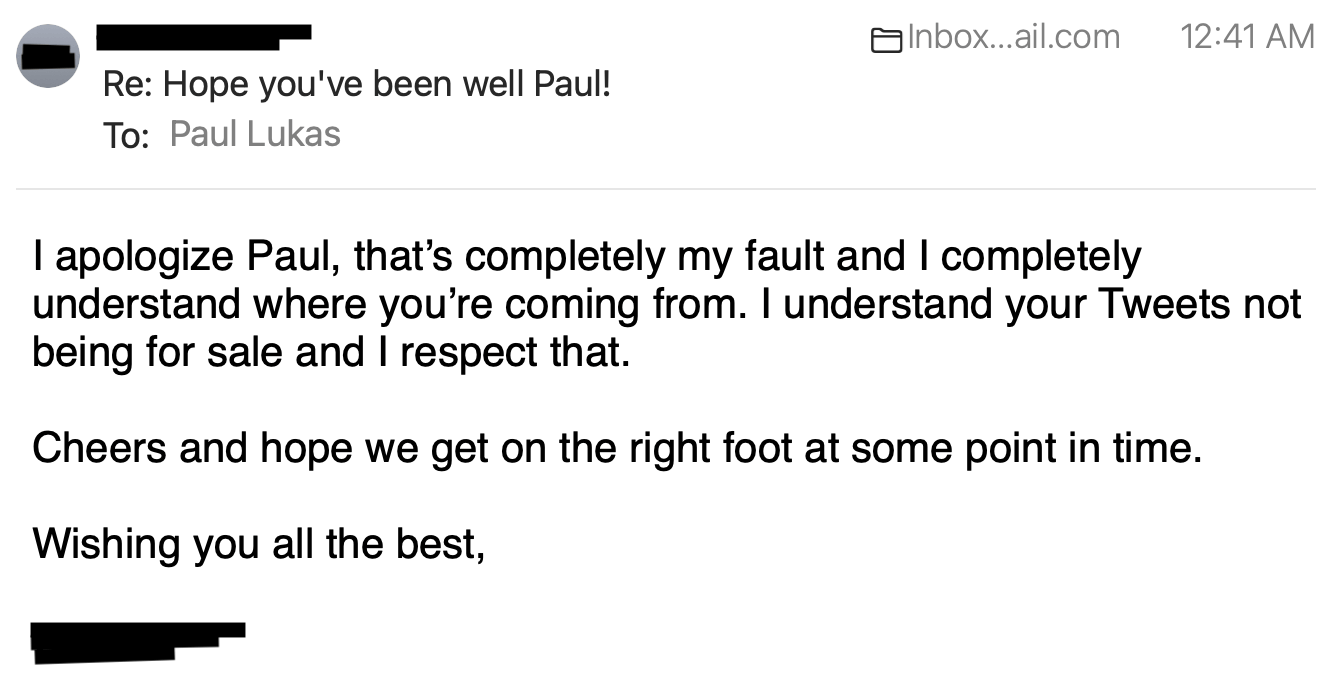
———
And that was the end of that. I’m not trying to make fun of Dave (on the contrary, he seems like a nice guy, and I’d say his final email was about as graceful as possible under the circumstances), but I do find it interesting that MLB has partnered with a company whose idea of a marketing plan is to bribe people for social media posts. It’s all pretty gross.
I’m sure Dave will find someone else who’ll be happy to accept his $500, and he’s probably making similar offers to other people (depending on how big his “marketing budget” is). So when you see lots of social media chatter about MLB/Candy NFTs next month, now you’ll know why.
If anyone at MLB is reading this: Come on, people — be better.
Update: As if on cue, the NFL has just announced the launch of “top plays” NFT collectibles. I look forward to their forthcoming bribe offer!

Click to enlarge (it’s worth it!)
Waaaay too good for the Ticker: Oh man, is this the greatest football program cover or what? So many great uniforms! My only gripe is that the two guys at the bottom have essentially the same uni (helmet notwithstanding) — seems like they could’ve dressed one of them differently, just for the sake of variety. But aside from that minor quibble, first-rate!!
The artist was Lon Keller — you can learn more about him here and here.
(Big thanks to @NFL_Journal for this one.)
The Ticker
By Alex Hider, pinch-hitting today for Lloyd Alaban

Baseball News: The Mets have reportedly hired a design firm to help “‘evolve’ the team’s brand” — whatever that means [this will almost certainly end in tears, probably mine — PL] (from @DoogieStardust). … The Dodgers wore their City Connect uniforms last night and will do so again on Friday (from Phil). … Speaking of City Connect unis, Red Sox beat reporter Alex Speier says the team will not wear their yellow alts on the road during the remainder of the regular season, even though MLB said they could if they wanted to (also from Phil). … Here’s a fun animation that shows how the MLB standings changed day by day throughout the 2021 season (from John Muir). … In a video shared by the Orioles, artists Ernest Shaw and Christopher Batten talk about the Negro Leagues mural they painted at Camden Yards (from @b_fianchetto). … Mike Engle notes that Blue Jays P Nate Pearson wears a ring on his left index finger — don’t think I’ve seen that in person, much less on a baseball field. … The West Virginia Power of the Atlantic League of Professional Baseball announced yesterday that they are changing their name to the Charleston Dirty Birds and unveiled their new uniforms (thanks to all who shared). … New York magazine published a think piece about the Atlantic League’s yet-to-be-named Staten Island club and what makes a team name “quintessentially Staten Island.”

NFL News: The Bengals will debut their orange jerseys and orange-striped pants tomorrow against the Jaguars (from Phil). … The Cowboys have opened a new space outside their stadium that includes a 70-yard football field (from Kary Klismet). … Bucs QB Tom Brady has a new line of clothing on the way (from Tom Turner). … The Packers are challenging a Los Angeles memorabilia company’s “Twin Title Town” trademark because they think it’s too close to their own trademark, “Titletown” (from Kary Klismet).
College Football News: Following up on yesterday’s lead: If you’re curious about color photos of Ohio State’s 1950s-era mono-red uniforms, as opposed to the black-and-white pics featured in yesterday’s post, here you go. That’s lineman Joe Campanella’s 1952 Bowman football card (from Josh). … Boise State will wear throwback helmets on Saturday (thanks to all who shared). … Oklahoma will wear white for the first time this season Saturday when they travel to Kansas State. According to @SoonerTracker, it marks the latest point in a season that they’ve gone without wearing white since 2004. … Cincinnati will wear black helmets, white jerseys, and black pants on Saturday at Notre Dame (from @UCUniforms). … Speaking of the Irish, next season’s Shamrock Series game will be in Las Vegas (from Phil). … Virginia will wear blue helmets, white jerseys, and white pants tomorrow against Miami (from our own Jamie Rathjen). … After Utah RB Ty Jordan died in December 2020, Utah created a memorial logo for him and gave his number, 22, to his high school friend and Ute teammate Aaron Lowe. Tragically, Lowe was killed earlier this season in a shooting, and Utah has updated Jordan’s memorial logo to honor him as well (from Trent Lowe).

Hockey News: The next two are from Wade Heidt: Blues G Jordan Binnington has a new mask design. … On Thursday, Canada will recognize the first National Day for Truth and Reconciliation — a day that honors Indigenous children who were forced to attend “residential schools” for forced assimilation. The Canucks played their first home preseason game Monday night and recognized the upcoming day of remembrance. Coaches wore orange ribbons, and players used orange tape on their sticks in warmups. … New alternate uniforms for the Regina Pats of the WHL (also from Phil).

Basketball News: Jazz PG Mike Conley is switching jersey numbers from 10 to 11 (from Phil). … For more on the latest in NBA numerology, head over to Etienne Catalan’s Twitter page. … Wizards G Spencer Dinwiddie says he tried to purchase the team’s jersey ad in the offseason in an attempt to advertise a cryptocurrency, but the league put the kibosh on it (from Phil). … New logo for FIBA Europe’s SuperCup Women competition (from Kary Klismet).

College/High School Hoops: Clearly copied from inspired by the Miami Heat, Florida Atlantic will have their own “Vice” alternates this season (from Andy Seeley). … A few Akron players have apparently leaked the Zips’ new road jerseys (from Jacob Farrar). … St. Edward High School (Ohio) has a new court design (from Tim Smith).

Soccer News: Puma’s club-name-on-front designs for several teams have been controversial, especially with fans of Borussia Dortmund. Luckily for them, the team has made a slight change to the jersey to make the team crest a bit more visible (from our own Jamie Rathjen). … Also from Jamie: Australia’s leagues are now called A-League Men, Women, and Youth (or A-Leagues, plural) and have new logos (also from Andrew Doran). … UEFA has asked Inter Milan to modify its away jerseys for Champions League matches and remove the snake the wraps around the shirt (from @TRiCKETTengland). … New uniforms for Trinidad and Tobago’s Women’s National Team (from Everard Santamarina). … The Rotherham United Women’s team has an unusual dot pattern on their uni numbers (from Graham Clayton).

Grab Bag: Kansas State has extended its apparel contract with Nike (from Phil). … The next two submissions are from Kary Klismet: West Ridge High School (Tennessee) has unveiled a wolf mascot sculpture made of scrap metal from the three area high schools it replaced. … New marching band uniforms for Permian High School in Texas and Missouri Western State University. … NASCAR drivers will have pink window nets during the Oct. 10 race in Charlotte to support breast cancer awareness (from Clark Ruhland and @mrmichael21). … Speaking of that race, here’s what Alex Bowman’s car will look like (from Trevor Williams). … Hershey’s is selling Halloween candy with BFBS wrappers that glow in the dark (from Al Barcheski Jr.). … The New York Times (soft paywall) challenged six designers to re-imagine the American flag. … Artist Martin Naumann put neon-themed spin on some of the world’s most well-known logos.
Our latest raffle winner is Kristopher Stahr, who’s won himself a bobblehead from FOCO. Congrats to him, and my repeated thanks to FOCO for sponsoring this one. — Paul
Paul, as gross as that MLB NFT story was, and I imagine it left you wanting a hot shower, that’s the kind of content that brings me in every day. They completely failed to read the room when approaching you on this. Anyone familiar with this site knows you’re a person of integrity. I hope “influencers” soon go the way of the Fuller Brush Man.
Man. It just seems to be coming from all sides lately. Uniform ads, this NFT stuff, more “branded athletes”…and also more and more voices complaining about “keeping things the way they were” for all the wrong reasons. It’s pretty overwhelming for this long time reader, and I can’t imagine what must go through the heads of Paul and Phil. But I applaud you both for staying on course – and I’ve never been more proud to be a reader than after reading this post. Kudos, folks.
The Rotherham United Women’s team has an unusual dot pattern on their uni numbers
That’s just the old EFL number font. But this item pointing that out made me realize that the dot pattern actually went away at the start of last season and nobody noticed, so I guess that’s why it looks unusual now.
The Rotherham United women appear to be using the EFL font from the 2018/19 season
Ah, I seem Jamie beat me to posting that here!
I can’t believe they could have gotten organic coverage of their product for free and turned it down. It would have been so much more valuable than what they were trying to pay for.
Bingo.
Yeah, but Paul’s write-up would have been TL;DR for Dave’s target social media demographic, I have a feeling. (Sorry, was that too cynical?)
Also: $500 seems like such a lowball offer to sell your journalistic soul.
I don’t think they fully realized that I’m a journalist (and/or that I have a soul). To them, I was just a guy with a 137K Twitter followers, and I imagine they offered me the going rate for this type of thing.
“The Canucks played their first preseason game Monday night”
Hi Paul, just a small correction on the Hockey Ticker item. It was the first home preseason game for the Canucks (in Abbotsford). The Canucks played their first preseason game on the road on Sunday. Were there in Spokane for the debut of the Seattle Kraken.
Got it.
A bummer about Dinwiddie being unable to buy the Wizards’ jersey ad due to conflict of interest. As a fan, I’d rather see an ad for something one of the players is invested in, especially since the actual jersey ads we get aren’t much more ethical.
I consider the entire concept of diluting your team’s visual brand with third-party advertisers’ logos to be a conflict of interest, but hey, what do I know? #nouniads
I would have stopped reading the guy’s first email at “the MLB.”
Publicists and marketers get stuff like that wrong all the time. I noticed it, for sure, but it wasn’t necessarily a sign of anything.
That struck me as so odd, almost like an AI-penned email. My response would have included, “I’m sorry. Are you referring to The Major League Baseball?!?”
Many of the people who discovered soccer an hour and a half ago refer to Major League Soccer as “the MLS” and this has apparently bled over.
People bribe for Twitter Posts? Next thing you’ll tell me is that water is wet…
I didn’t say it was a new phenomenon — in fact, I specifically noted that it happens all the time.
What I said was that I never thought I’d be approached to be part of it, and that it’s interesting that MLB is going this route.
That’s all.
And just making my point of how sleazy social media has become. It’s been completely ruinous to our society.
That’s all.
That depends on whether people pay any attention to this type of thing. You don’t have to if you don’t want to.
As far as social media goes I have a FaceBook page I hardly ever log into. I do not have a Twitter account. I am not even sure what you are supposed to do on Instagram or Tik Tok. I’m the wrong person for an influencer to try to influence.
…although water itself is not wet, according to science.
Regarding the 70 yard football field outside Jerry World:
70 yards is the field length for official NFL Flag Football youth league games, so I would imagine it ties to that in some way.
I volunteered to coach my son’s team this year and had to do a double take at the rules when I saw 70 yard field.
Any chance those football uniforms on the program cover were supposed to represent real Georgia Tech opponents? There are eleven.
Great question. I doubt it, but it’s a fun thought!
I doubt it would be Georgia Tech opponents as the game was at Notre Dame.
But I do wonder if it represents a certain conference. With all the rainbow of colors available why would there be four red jerseys?
The other thing that jumped out at me was the all-gold uniform. There’s only one school that I can think of that would use white numbers instead of dark ones and that would be Tennessee.
How about the stupidity of “owning” the “MLB play of the day”… owning highlights? Give me a break. You can’t own a highlight. What a bunch of nonsense.
As soon as I see anything related to NFTs, I think “scam”. Maybe that’s too harsh of a word, but I can’t find a better one.
I figure a highlight is worth about 1 gazillion JoeCoin(R)
A quick update: As if on cue, the NFL has just announced the launch link. I look forward to their forthcoming social media bribe offer!
This is why I cannot understand the concept of NFT. How does one own a baseball highlight? Presumably it is property of MLB/its teams and is allowed to be rebroadcast under various terms by its broadcasting partners. If you were to own said highlight as an NFT, does that then mean various sports media outlets could no longer show the highlight, or would have to pay you to show it?
Also, assuming this company reaching out to Paul wasn’t a mistake, it is pretty gross to think of other journalists being paid directly by companies to include them in their “content”. However it does speak to the nature of media content today, the line between actual news, paid advertising, and sadly paid propaganda is blurred beyond belief.
Appreciate Paul’s journalistic integrity here.
Look for the Mets to get new updated uniforms
Yeah, this is scary. It’s also what happens with new ownership groups, it seems.
I just hit me why I dislike the Bengals new unis. It’s as if the helmet and jersey is one design and the pants come from a completely different uniform set. It’s so mismatched.
I’m not a journalist but I am a blogger and the number of requests I get for “partnered” content, paid content, etc. is astounding.
They sell it as “you don’t have to do any work”, they supply the content and pay me. I’m supposed to credit them as “guest blogger”.
The hilarious part is that 99.9% of them have clearly never read the blog or even know what its about. After 600 posts in a row on a pretty narrow topic read by a couple thousand industry professionals in a very narrow industry, what makes you think that a blog post by a “guest blogger” on a topic completely unrelated to the previous 600 posts would be anything me or my readers would be interested in.
At least the MLB NFT post is on brand, if nothing else. I’d love to see the pitches that Paul gets for “partnered posts” from idiots wanting to do a sponsored post about mesothelioma settlements or synthetic driveway materials (both of which I’ve gotten pitches for in the last month).
So you don’t flag/label those posts as paid content, Mike? (Not judging, just asking.)
I don’t take them so its not an issue. Sorry if that wasn’t clear.
I’m just laughing about how they think that their shitty content about whatever it is they’re pimping would somehow “be a fit” for our corporate law blog.
Ah, gotcha.
Is it Bob Loblaw’s Law Blog?
We’re dropping law bombs
Paul, if you’re looking for a great way to inform folks about NFT’s, Cardinals soon-to-be-retired play-by-play man Mike Shannon broke it all down plain as day during a game in August. Well worth checking out. #nofriggintouchdowns
link
That’s hilarious — thanks for sharing!
Are the Hershey wrappers really BFBS or BFHS – black for Halloween sake?
Those orange Bengals jerseys look a lot like the Bears’ orange jerseys? Cut from the same cloth?
This post got me thinking about old-school in-show radio ads, where a talk show host would naturally segue from whatever he was talking about as part of the show into a paid advertisement, and you could tell they were trying to do it naturally so the advertisement came off as an organic part of the show, rather than what it actually was.
The situation Paul describes in this post does seem pretty unethical to me, but I never had a problem with those kinds of radio ads. So now I’m wondering what the difference is. Maybe it’s because, despite their best efforts, radio ads were still always pretty clearly ads. I never felt like I was being misled (even if that was the intent).
So then that got me thinking… In a situation like this, do you have the option of making some kind of clarifying statement in your paid tweet like “The preceding tweet was a paid advertisement”? It seems like that’s all that would be necessary to keep the process ethical, but I’m guessing the people paying for it don’t allow that?
Not really an apples:apples comparison, Daniel.
On a TV or radio show, you know that the business model is predicated on advertising and that just about anytime the host is talking about a third-party product, that’s because they’re being paid to do so. Sometimes this is paid relationship is obvious, but even when it sounds “natural,” you know it’s transactional, because that’s how the business is set up.
But if I’m being paid to say nice things about a product on Twitter, that’s a very different situation. As it stands *now,* if I say on Twitter that I like a certain movie (or whatever), it’s because I genuinely like the movie. But if I start accepting money to say nice things about this or that, then you can never know which things I say are “natural” and which are transactional. There’s no transparency. That’s why it’s so insidious and unethical.
Now, if I said “I love this movie” (or whatever) and then added, “I was paid to say that,” that would at least be more transparent. But as you correctly anticipated, the person paying me wouldn’t like that. More importantly, I have no interest in selling my tweeted opinions (with or without transparency). That’s not available for sale.
It’s an interesting question as to whether it’s unethical for a journalist to accept money in exchange for a message intended to “influence” an audience. As someone pointed out above, it’s pretty common for radio and TV announcers to record advertising spots and/or read off a list of sponsors/advertisers for their show. Granted, it’s usually pretty obvious that these are advertisements but I do remember that Paul Harvey used to kind of blur the line and I guess nobody had a problem with it.
I do give Paul credit for not being willing to accept money to do something he wasn’t comfortable with and might harm his credibility, especially in today’s environment where it sounds like it’s pretty tough to make a living as a journalist.
But at the end of the day, most journalistic outlets are accepting money from advertisers/sponsors, and it’s reasonable to assume that if a newspaper is getting money to run ads from, say, Apple, they might be less likely to run stories or opinions that are critical of Apple. So the line is often going to be a little blurry I think.
But at the end of the day, most journalistic outlets are accepting money from advertisers/sponsors, and it’s reasonable to assume that if a newspaper is getting money to run ads from, say, Apple, they might be less likely to run stories or opinions that are critical of Apple. So the line is often going to be a little blurry I think.
Actually, that is not reasonable at all, and that’s not how real journalism works. Real journalistic outlets have strict church/state separation between their editorial and advertising operations. The newsroom doesn’t know who’s buying ads (and doesn’t even *want* to know).
Wait, there’s a real journalistic outlet still in existence?!?
Hilaaaaaaaarious.
But to answer your question: Yes.
I really love the Dirty Birds logo, and the story of why they used a canary makes it even better. MiLB logos and nicknames are some of the best in sports.
The word mark don’t looks like angry birds… and that angers me.
Maybe now that Topps lost the MLB partnership, they’ll put out a special “People who ticked off Major League Baseball” collection.
Jasper, you’re exactly correct. I interned in a mid-size town newspaper in which the local Wal-Mart advertised virtually every day. I reviewed letters to the editor and anything critical of anything that happened at Wal-Mart were ditched. They never ran. Then there was a case against Wal-Mart, reporter interviewed people for it. The article never saw print. I moved on, so maybe Paul’s belief that there is a wall between news and marketing at newspapers is a new phenomenon.
It’s not new at all. If your paper was doing that, that’s completely unethical and disappointing.
Would you care to name the mid-sized town and/or the newspaper?